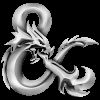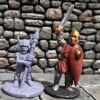Fringe Review: Starships & Spacemen from ZDL's blog
We're reaching deep into the wayback machine for this review. Today's fringe gem is another game from the (in)famous game publisher Fantasy Games Unlimited (FGU). As I said in an earlier review of Psi World, FGU was a game company willing to champion and publish any game concept imaginable (with predictable mixed results in quality and sanity). One of the games I mentioned in my capsule history of them is a very rare beast called Starships & Spacemen (S&S).
History
S&S is a very early RPG publication ... and it shows. Designed by—and I am quoting this directly from the title page—"Captain Leonard H. Kanterman, M.D., U.S. Army Medical Corps" and published in 1978(!), this is not the first science fiction RPG ever published, but its publication comes very shortly after Metamorphosis Alpha and is contemporary with Gamma World's first edition.
It is, in short, a very early example of gaming arcana.
Because of its publishing provenance, this game is almost unique among early space opera-focused games in having not been influenced much by Star Wars. Sure, yes, Star Wars came out in 1977, but playtest copies of the game were already deep in the works, according to notes from Scott Bizar in the foreword, as far back as 1976. So unlike FGU's own Space Opera game, or GDW's Traveller, the primary feel of the game is not Star Wars with the serial numbers filed off. No, it is instead Star Trek with the serial numbers filed off.
This leads to unexpected subtlety in a game of that era with a few concepts I'm pretty sure are firsts for RPGs.
Note:
This game has seen a republication of sorts in the form of a second edition published in 2013 by Goblinoid Games. This "republication" is essentially a rewrite of the game making it compatible with that company's Labyrinth Lords rule set is is not the version being reviewed here. I have no opinions on the second edition except to say I'm not really interested in it and thus cannot share any impressions of it. This review is specifically of the FGU 1st edition only.
Starships & Spacemen
S&S came in a single, 88-page staple-bound book typical of the era. (Indeed players of Space Opera will recognized the cover style instantly: all-black but for a single illustration on the front cover done in black and white). The art in the book (badly-rendered little diagrams and maps aside), from the cover on, is done by Rick Bryant and is of surprisingly high quality for that era of game publishing. Given his later works in comics and commercial illustration, however, it's clear that the good doctor lucked in with his collaborative partner. There isn't a lot of Bryant's work in the book, but what work is there is very well executed and a rare treat.
The layout is typewriter chic. It looks exactly like you'd expect someone copying typewritten pages (right down to cursive script occasionally used that is identical in all respects to a typewriter my mother had when I was young!) and reproducing them in book form would look. It's all uniform except for section headers which very clearly look like they were pasted in place (right down to the little tell-tale alignment errors of that approach).
It's not pretty, to put that in other words, though it is mostly functional and usable (which, in the end, for actual play, is more important than looking pretty).
The Setting
Unusually for the time, S&S came with a setting, one very obviously inspired by Star Trek and, obviously, given the publication date, specifically the original series. It has had the names changed and the serial numbers filed off for ™/© reasons, but remains recognizably an attempt to reproduce the Star Trek universe for role-playing purposes.
Under the heading of "Science Fiction Rationale" (?) the history of the setting is explored. In a terse, but surprisingly readable and informative, style it starts off by mentioning humanity's (alternately "Earthmen" and "Terrans") initial tumultuous, not-at-all-peaceable journey out into space until they met the ruling space-faring race, the Klingon stand-ins called "Zangids", a society hell-bent on galactic domination. The Zangids, described as … Oh dear, the politics of the time are certainly showing here! … "humanoids resembling Terran Orientals", got into a war with the Terrans almost immediately and the Terrans were on the brink of disastrous loss when they organized alliances with other Zangid foes to fight back. Thus entered the Taurans (Vulcan stand-ins), Andromedans (three-sexed, incestuous anti-Vulcans, almost, with better psionic powers), and the Rigel (stand-ins for the genetically engineered types like Khan). The Rigel …
Oh dear! … This is very much a game that is the product of its time. I will NOT be going into details of the Rigel's background except to mention that it hints at slavery (including sexual), and mass rape. ON THE GOOD GUYS' SIDE! This is a kind of background that if published today would get the publishers pounded and the writers dog-piled to death on social media. It was a bit of a blotch on the game when I first encountered it so many years ago and I basically spent most of my time playing it looking at everything except this page of the background, finding it even then a bit stomach-churning.
It has not improved with age. Especially with the stand-ins for Iran (the Videni, playing the role, kinda/sorta, of the Romulans) and their holy crusade to conquer the galaxy for their religion, led by "Mahdis"…
If this is as far as you get before losing interest in the game, I understand completely. It shook me too and is probably one of the reasons why I later got into Space Opera so heavily instead of continuing with this game. (Another reason is that Space Opera is just lunatic fun!) But that is a shame, really, because the … dubious … political backdrop aside, the game is actually quite good and a bit ahead of its time. So if you're still with me, having broken past the three pages of background, let's look at the system.
Characters
The game uses primarily d6 and d20, though "other polyhedra dice can be useful". Characters are—stop me if this sounds familiar—generated by rolling 3d6 for each of Marksmanship, Intelligence, Technical Skill, Contact Skill, Charisma, and Strength. These may be rolled in order, rolled one by one and assigned after each roll, or rolled six times and assigned afterward en masse.
OK, so maybe not that familiar.
This is obviously an attempt to make systems that are suited to the setting instead of thinly papering over Dungeons & Dragons which most games of the time were doing. The DNA is obvious, but the mutation is equally so.
Two stats—Psionic Potential, and Loyalty—are handled differently. Each of these has a base value by race and sex (oh dear!…) and then have 1d6 added.
The abilities have … unusual naming conventions in many case. "Marksmanship" really means "Dexterity/Agility" in almost every other game for example. "Technical Skill" is what it says on the tin while "Contact Skill" deals with communications and, of all things, fire control. "Loyalty" is the standout for weirdness. It's a mutant blend of willpower and willingness to follow orders.
Part of the issue is that this being the early days of gaming, the distinction between "characteristics" and "skills" was … very loose. This has a bit of an impact on game flexibility, and usually I would chafe against this, but in this game, with its Star Trek-like setting, it actually fits. The selection of stats pairs with careers and thus, in effect, bridge positions on a ship. Like the show it is based on, or the "old school" RPG ethos, the game system's "physics", so to speak, supports a very specific style of play.
Once stats/skills are generated, a race is chosen. Races have bonuses and penalties on stats (differentiated by sex … oh dear!) as well as special abilities by virtue of inbred ability, preferred branches of service, avoided branches of services, as well as limits as to number on board a ship.
After this a major branch (military, scientific, or technical) of the Space Fleet must be selected and, optionally, a subclass under this branch (for military, e.g., Command, Security, and Fire Control) may be selected. Each branch has a "prime requisite" stat which must be 9 or greater to have the character enter. Each subclass has an additional "secondary requisite" which must be 12 or greater.
One of the innovative mechanisms of this game—a mechanism that's seen fitful use in RPGs published since—is that characters get experience for differing actions based on their "branch" and "subclass". For example military branch characters get experience for defeating enemies in combat, while the Alien Life subclass of the scientific branch explicitly gets NO experience for combat. This is a notion seen in games like Chivalry & Sorcery, Rolemaster, and a few others, but it is somewhat of a rarity in RPGs even today, not to mention in games of this era. Sadly this innovative feature is somewhat marred by a distinctly D&D-ish vibe of experience ranking (paired, ludicrously, with military ranks like the old D&D level titles, but taken literally) each level of which involves increases in stats, in available equipment (equipment is a bizarre blend of allocated by Space Fleet but also personal possessions) and the starship commanded by someone in the command subclass. That part is a bit of a mess that doesn't quite emulate the source material. Further there are level limits by branch/subclass which also feel out of place, though at least these have some in-game rationale. (A communications specialist as Admiral of the Navy?...)
Every ship, according to these rules, should have at least one PC from each branch, and, as a further constraint, MUST have one command and alien life subclass member each.
Characters may be named anything, but suggestions include being named by various conventions by race and this can get a bit silly. Taurans, for example, recall these being the Vulcan stand-ins, have two-syllable names with the second syllable ending in 'k'. Example names given: Red'nek and Bottle'nek. Picture me rolling my eyes here. Then comes a really bizarre bit out of left field: they may be given any Yiddish name as well—Shlock, Shlemiel, Schmendreck, Bubele, etc.—because, and I am absolutely not making this next phrase up!, "they are the descendants of the Ten Lost Tribes".
What. The. Flying. …?
We basically just ignored that section….
Spaceships
There are four classes of ship available to command subclass characters to command: Destroyer, Cruiser, Battle Cruiser, and Dreadnought. Other ship types are essentially "NPC" ships. If you've ever watched a single episode of any Star Trek show you already know how ships work, though the warp drives are now "hyper drives" and the impulse engines are now "nuclear drives" and other such hasty filing down of Star Trek treknobabble replaced with its own version here.
Interstellar movement is done by hex-crawling on a GM (sorry SM) made galactic map where each hex is one light year and movement goes by one hex per day per "warp factor". The speed of travel has energy costs which must be paid, and energy management is a major portion of the operation of starships.
Combat is performed using "lasers" and "ion torpedoes", and defensive screens. Transport to and from destinations from the ship is performed with "teleporters" and shuttles. Other familiar-sounding equipment ships have include tractor and pressor beams, sick bays, talking ships computers, a "power pile" … OK, if you've watched any episodes of Star Trek you already know what space ships are like. (You will also have no difficulties figuring out personal equipment for similar reasons.)
One interesting detail of ship operations is the focus on energy management. EVERYTHING uses energy and if the ship runs out of energy it is dead until it can generate more. This is a feature in a role-playing game that was published a full year before Star Fleet Battles turned gamers everywhere into accountants who would occasionally move a chit on a hex grid before grinding numbers again…. (Unlike SFB, however, <bigotry>Starships & Spacemen is actually a fun game</bigotry>.)
The huge difference between the wargame and this role-playing game becomes clear when you compare space combat. Space exploration in S&S involves detailed power allocations, hex map movement (with optional 3-D component if desired), and all the other kinds of stuff you'd expect to find in a game of SFB, but actual combat is done abstractly without a hex grid. Indeed the only thing kept track of aside from ship systems status in the space combat system is …distance. Not even facing is dealt with. To-hits are rolled on d20 by range (modified by the presence of a fire control officer, with one rule's glitch concerning whether or not the bonus for such is +2 or +3). "Lasers" are 1d6 time 5 in damage and heavier weapons (the "ion torpedoes" of the Space Fleet or equivalent weapons on the other sides) are 1d6 times 10. Damage is mitigated by "screens" and any left over leaks into the ship itself. Damage is taken in the form of energy, so if players have wasted a lot of energy, their ship is close to destruction should they be forced to fight. Rules for disengagement and fleeing are supplied to avoid that messy end.
Game play
I think S&S is the first example of a so-called "hex crawl" game. (It is certainly the earliest example I know of personally.) The given structure of play starts with a mostly-blank map from the player perspective. The SM has a master map with all hazards, etc. mapped on it, but the players are given a map with their starting place, their destination(s) marked, and perhaps some pre-known hazards marked. They must then move at "interstellar travel" scale, mapping out movement, allocating energy, and exploring space. Courses are plotted in advance on a daily basis and then executed one hex at a time. Hazards may be avoided (if of the variety that give warning) or may just be fallen into headlong. If all of this is survived, however, the players enter a mode of travelling within a star system at their destination.
The hazards continually mentioned are typically taken almost verbatim from Star Trek: intelligent clouds, space amoebas, time warps, etc. along with a few interesting hazards unique to this game (my favourite being "space mirrors").
Travelling within a star system is done on an hourly turn basis and is much simpler than interstellar travel. It is here where energy is regenerated and in-system movement is dealt with. There are 20 such turns each game day. At some point the players will undoubtedly reach the stage of planetary exploration (or equivalent).
Planetary exploration works in turns of one hour, periods of five or 10 minutes, or combat rounds of 1 minute. All in all a very old school game design, with the varying scales of movement and turn lengths very reminiscent of the later Starfire III: Empires. The planetary exploration scale mostly involves travel between planets and orbiting them, as well as, naturally, spaceship combat. Simple rules for environments, time travel, diseases, and other such Star Trek tropes are provided, but as with most games of this era the heavy lifting is done by the SM. Fortunately the rules as a whole are sufficiently simple that this is not much of a burden. Supplementing these simple rules are extensive tools for encounters, both random and planned.
Combat
As mentioned before combat is performed in one-minute rounds. Each character is permitted one action per round (though some alien tech will permit this to change). Actions are deemed simultaneous unless there is an element of surprise involved in which case the surprising side gets one free action with no response. Movement to close range is a free action.
Ranged attacks are performed with a d20 roll under the character's Marksmanship, modified for range, encumbrance, etc. On a hit damage is scored (or special weapon effects are resolved). It is a very simple, very fast-moving system, in short, without the page after page after page of modifiers, tactical options, and movement rules of other games both of the era and later. Close combat is performed by comparing a close combat score based on strength and a d6 roll, the compared results dictating which character takes what effect. That same strength score is the maximum number of hits of damage a character can take before dying.
It is that stark, yes. Take a number of hits equal to your strength over the course of a combat and you're dead. This is very old school in design.
And the rest
S&S does not offer a lot of SM guidance. Four pages. Two of which are actual guidance, one of which is experience awards, and one of which is lists of influences. This is not a game for beginning GMs (to put it mildly). This is followed by four pages of sample adventures, which are really more adventure seeds requiring the SM to do groundwork to get ready to play. (This is my favoured approach so I don't view this as a negative.) Extra reference cards provide the character sheet, a character generation summary, as well as stats for personal equipment and starships.
Let's talk Goethe
Using Goethe's structure for criticism, I need to answer three questions in order:
1. What was the game designer trying to accomplish?
2. Did the game designer accomplish this end?
3. Was this an end worth accomplishing?
For the first question, the answer is simple: the game designer was trying to make a game that would let him do role-playing adventures in the style of his favourite television program: *Star Trek*. Every page oozes this goal and it would be hard to claim that any other goal was important to him.
For the second question, the answer is more complicated. Some elements of the game—even the "retro" "quaint" ones like the confusion between stats and skills—are actually quite suited to the intended goal. The "physics" of the game mechanisms actually supports the teamwork and diversity of speciality that you see in actual Star Trek episodes. In this regard the good doctor has done a good job.
That being said…
This game is very much a very old school design with many of the flaws of that format. A stand-out for this is the experience system. While it does feature the then-unique notion of getting experience for doing what your type of character should actually be doing, it falls into the levelling up trap. It has been many years since Star Trek was on television, but I'm pretty sure that in its run we didn't see the crew of the Enterprise start off in a destroyer and then beat up space guys/monsters/anomalies to earn a cruiser and then a battle cruiser... Other such flaws also exist, so the answer to the second question is "yes ... mostly".
Which leaves question #3.
This is a tough one. I'm a fan of Star Trek and of this game (some ugly things implied in the setting aside). I think for its time it was a bold effort to break free from RPGs' wargaming roots. The fact that starship combat is explicitly called out as an afterthought and that combat is quick and lethal (and thus something to be largely avoided) is a good thing. (Look at the source material again: when phasers were fired on anything but stun, people mostly just vanished. No survivors.)
But…
I think it came too early. Nobody in 1978 was screaming for a game that we would nowadays call "dramatist" (using the deeply flawed "threefold model"). There's a reason why you probably never heard of this game or, if you'd heard of it, likely have never seen a copy of it. Even with its throwbacks to D&Disms it was still too radical a shift in thought for most people and I think that this made any chance of popularity suffer.
Specifically I think it was about ten years too early.
So it was a worthy goal attempted too soon and suffered for it in many ways ranging from execution to popularity.
It still generated quite a few hours of enjoyment, however, for certain people (myself included) so obviously I think it was worth it….
















The Wall